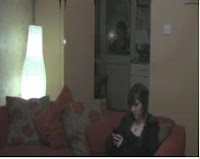Our horror film's main character reinforces dominant representations of that particular social group - a vulnerable 16 year old girl being the victim. We accommodated the vulnerability into our film by shooting at night and in the victim's home. Accompanied with twitches and body language to suggest nervousness and uneasiness, the actress instantly portrays vulnerability (as home is the one place you expect to feel safe). This representation also conforms to the stereotype that the younger a person the more innocent and at risk they are and that females are stereotypically more weaker and more timid than males.
An example of this can be seen in Nightmare On Elm Street, with Freddy Kruegar standing behind his innocent victim, Nancy Thompson. As you can see below Nancy (the teenage girl) is perched on her bed looking down, solemnly whilst Freddy is stood looming behind her, his presence unknown to her. This image portrays the male character with holding dominance whilst the teenage girl connotes innocence and vulnerability and we included a similar shot in our film, where the main character (also a teenage girl) is sat on her living room sofa and the feral zombie threat is lurking behind her in the doorway. We hope that this will reinforce dominant stereotypes to do with teenage girls and create a feeling of uneasiness at the same time.
In our zombie film we cast young adults/teenagers as zombies to represent a sort of feral threat to mirror the general threat in society today (teenagers with ASBO's being famous for deviant behaviour). I believe that this worked well as our film represents contemporary fears by tapping into the primal fears of society- the fear of being targeted by the younger 'ASBO' generation. We cleverly reflected the tabloids use of exploiting fears in society by deliberately using this younger cast which we based on a British TV Drama, 'Misfits'. As seen by the image below, the zombies and 'civillians' are all of a very similar age range but despite no age gap, they are primarily still the threat/enemy, and not the friend. They are also set apart by their clothing which we also wanted to portray as hodded youths to clearly establish that they are not unlike from the children of today. Our actors/actresses below are clearly set apart with zombies, like 'chavs' dress in their casual dress sense in comparison to the majority of teenagers who are fashion conscious.
Misfits (as seen in the image above) are a prime example of how media institutions other than film companies portray the younger generation as a threat and connotes the consequences of breaking the law with criminal acts. We think that this image is effectively the way how older audiences perceive younger generations as a "threat" and clearly from the image above, "law breakers" and this is exactly how we want our zombies to appear to these older audiences.
An example of this can be seen in Nightmare On Elm Street, with Freddy Kruegar standing behind his innocent victim, Nancy Thompson. As you can see below Nancy (the teenage girl) is perched on her bed looking down, solemnly whilst Freddy is stood looming behind her, his presence unknown to her. This image portrays the male character with holding dominance whilst the teenage girl connotes innocence and vulnerability and we included a similar shot in our film, where the main character (also a teenage girl) is sat on her living room sofa and the feral zombie threat is lurking behind her in the doorway. We hope that this will reinforce dominant stereotypes to do with teenage girls and create a feeling of uneasiness at the same time.
In our zombie film we cast young adults/teenagers as zombies to represent a sort of feral threat to mirror the general threat in society today (teenagers with ASBO's being famous for deviant behaviour). I believe that this worked well as our film represents contemporary fears by tapping into the primal fears of society- the fear of being targeted by the younger 'ASBO' generation. We cleverly reflected the tabloids use of exploiting fears in society by deliberately using this younger cast which we based on a British TV Drama, 'Misfits'. As seen by the image below, the zombies and 'civillians' are all of a very similar age range but despite no age gap, they are primarily still the threat/enemy, and not the friend. They are also set apart by their clothing which we also wanted to portray as hodded youths to clearly establish that they are not unlike from the children of today. Our actors/actresses below are clearly set apart with zombies, like 'chavs' dress in their casual dress sense in comparison to the majority of teenagers who are fashion conscious.
Misfits (as seen in the image above) are a prime example of how media institutions other than film companies portray the younger generation as a threat and connotes the consequences of breaking the law with criminal acts. We think that this image is effectively the way how older audiences perceive younger generations as a "threat" and clearly from the image above, "law breakers" and this is exactly how we want our zombies to appear to these older audiences.
We also researched into the way in which tabloids portrayed this younger generation of today, a prime example of this was in The Daily Star, who reported that a gang of teenagers shot a girl of 5, leaving her in critical condition. They name the group, "mindless thugs" and also refer to them as "hoody thugs". This article is a typical example of how they exploit serious criminal offences to install fear in members of society and this is the exact fear that we hoped to incorporate into our film.
 |
| Article taken from the Daily Star at... http://www2.dailystar.co.uk/news/view/184017/Tamil-Tiger-fighters-put-price-on-bike-gang-s-head-/ |




No comments:
Post a Comment